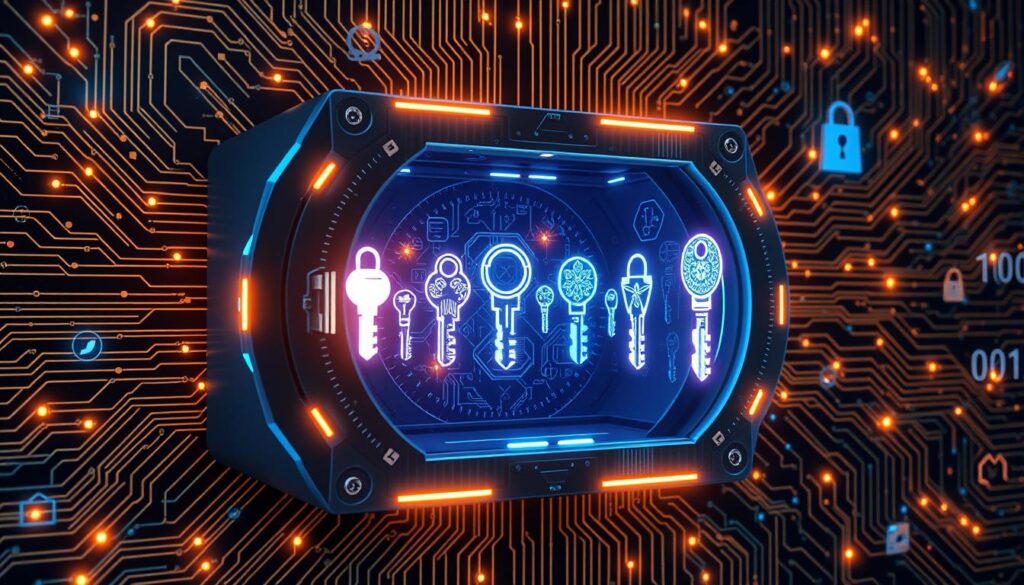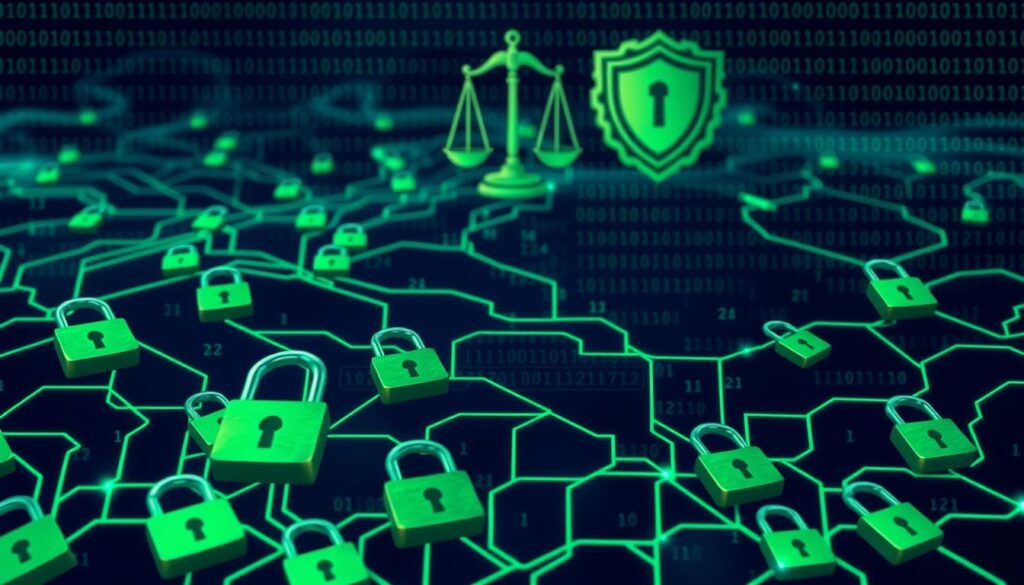Did you know that over 90% of all online communications are secured using cryptography? In a world beset by data breaches and cyber threats, cryptography stands as a critical safeguard. It enables both individuals and organisations to shield sensitive information effectively. This art of encrypting messages ensures that only the intended recipient can decode and access the contents, solidifying its role in digital security.
The fundamentals of cryptography involve diverse techniques and principles, crucial for information security. As technology evolves and cyber threats escalate, grasping these foundational cryptography elements is more imperative than ever. Whether securing online transactions or protecting personal communications, mastering these principles equips you to confidently traverse the digital realm. Delve deeper into securing your future with effective strategies here.
Key Takeaways
- Cryptography is vital for securing online communications.
- Encryption processes ensure that sensitive data remains confidential.
- Understanding cryptography is increasingly important in today’s digital age.
- Mastering cryptographic techniques enhances information security.
- The art of cryptography is evolving alongside emerging cyber threats.
What is Cryptography?
Cryptography is a cornerstone in the realm of information security, encompassing a range of methods to secure communication. It transforms readable data into an unreadable form, known as encryption, thereby safeguarding sensitive information from unauthorised access. This role is paramount, especially in today’s world where personal and financial data are frequently at risk.
Definition and Importance
At its essence, cryptography employs encoding techniques to protect data. This ensures that, even if data is intercepted, its contents remain undecipherable. Both businesses and individuals depend on these cryptographic methods to safeguard confidential data, ensuring privacy and data integrity. As digital interactions grow, the need for robust encryption to foster trust and confidence in information exchange becomes more critical.
Historical Context
The history of cryptography shows its progression from simple ancient techniques to complex algorithms today. The Egyptians utilised basic ciphers for secret messages, setting the stage for future advancements. Over the centuries, cryptography has evolved dramatically, incorporating advanced methods with the advent of modern computing and the internet. Today, its significance in information security underscores the continuous need for secure communication channels.
Key Principles of Cryptography
Grasping the fundamental principles of cryptography is crucial for safeguarding sensitive data. These principles are pivotal in ensuring confidentiality, integrity, authenticity, and non-repudiation. Each principle is essential for protecting data and enhancing trust in digital communications.
Confidentiality, Integrity, and Authenticity
Confidentiality shields information from unauthorised access. Encryption techniques are employed to ensure only those with the correct keys can access sensitive data, preserving its privacy. Integrity ensures data remains unaltered during transmission. Any changes are detectable, allowing recipients to verify the information’s accuracy. Authenticity confirms the identities of communicants, ensuring the sender’s authenticity and the message’s integrity.
Non-repudiation
Non-repudiation prevents individuals from denying their actions. This principle enhances trust in transactions and communications, as parties involved cannot later dispute their participation. Cryptographic mechanisms, such as digital signatures, act as irrefutable proof of an action or agreement’s occurrence.
Types of Cryptography
Grasping the various types of cryptography is crucial for understanding how secure information is transmitted and stored. Each type boasts unique advantages, making it suitable for different applications.
Symmetric Encryption
Symmetric encryption uses the same key for both encryption and decryption. This efficiency is ideal for encrypting large data sets swiftly. However, the challenge of key distribution arises, as both sender and receiver must securely exchange the key. Algorithms like AES and DES are prominent examples of symmetric encryption.
Asymmetric Encryption
Asymmetric encryption, on the other hand, employs a pair of keys: a public key, which can be shared freely, and a private key, kept confidential. This method allows for secure exchanges without the exchange of sensitive keys. It is essential for establishing secure internet connections, enabling secure emails and digital signatures. RSA and ECC are notable algorithms in this category.
Hash Functions
Hash functions play a distinct role in cryptography. They generate a fixed-size hash value from input data, ensuring data integrity. Each input produces a unique hash, facilitating the detection of any alterations. Hash functions are used to secure passwords and verify data integrity in numerous systems. For a comprehensive understanding, delve into this detailed overview on cryptography types.
Cryptography in Everyday Life
Cryptography is crucial in our daily interactions, ensuring safe and secure communication. It safeguards personal information, keeping data private during transmission. This digital security measure allows users to trust that their communications, via email or messaging apps, remain confidential and protected from malicious attacks.
Secure Communications
In today’s world, secure communication heavily relies on cryptographic techniques. For example, email encryption acts as a strong barrier against potential eavesdroppers, ensuring sensitive discussions remain within the intended audience. Secure websites also employ HTTPS protocols, built on cryptographic standards, to provide a safe browsing environment. This protection is based on cryptography’s fundamental principles, reinforcing the trust users have in online interactions.
Online Banking and Shopping
Cryptography is indispensable for online banking and online shopping. Every transaction is fortified with encryption, securing personal and payment details from unauthorised access. This combat against fraud and data breaches allows users to explore shopping platforms confidently, knowing their financial information is protected. This trust empowers consumers, enabling them to engage with various services and platforms without anxiety, fostering a thriving online marketplace. Learning more about coding and cryptography can further enhance one’s understanding of these systems; you can explore programming courses that cover these important topics.
Cryptographic Algorithms Explained
Cryptographic algorithms are crucial for secure communication and data protection. Symmetric and asymmetric encryption are two key types, each vital in modern cryptography. The choice of algorithm greatly affects the security and efficiency of systems.
AES and DES
The Advanced Encryption Standard (AES) and Data Encryption Standard (DES) are prominent symmetric encryption algorithms. AES, designed to supersede DES, boasts strength and efficiency. It employs key lengths of 128, 192, or 256 bits for enhanced security. Conversely, DES has a 56-bit key length, rendering it less secure today. Understanding these algorithms parallels the importance of effective resource management in personal finance.
RSA and ECC
Asymmetric encryption algorithms, such as RSA and Elliptic Curve Cryptography (ECC), fulfill distinct yet complementary roles in cryptography. RSA leverages the mathematical complexity of large prime numbers for secure key exchange. ECC, meanwhile, offers superior security with smaller key sizes, ideal for mobile devices and resource-constrained environments. The evolution of these cryptographic algorithms is essential for safeguarding our digital world.
The Role of Key Management

In the realm of cryptography, key management is paramount for data security. It encompasses a broad spectrum of activities, from generating to destroying cryptographic keys. Without robust key management, the security of these keys is at risk, potentially leading to the exposure of sensitive data.
What Is Key Management?
Key management is the systematic approach to handling cryptographic keys from creation to disposal. It includes key generation, distribution, and storage. Poor key management practices can create substantial vulnerabilities, enabling data breaches and other security threats.
The Importance of Secure Keys
The importance of secure keys cannot be overstated. They are vital for encrypting and decrypting data, thereby protecting it from unauthorised access. Implementing effective key management systems is crucial for maintaining the confidentiality and integrity of these keys. Achieving excellence in this area significantly reduces the risk of data loss and compromised security. For more information on best practices in key management, visit this link.
Understanding Cryptanalysis
Cryptanalysis is pivotal in cryptography, aiming to uncover the secrets behind encrypted messages. It involves identifying vulnerabilities in algorithms, enabling cryptanalysts to decode data without the original keys. This delicate balance between cryptography and cryptanalysis is crucial for maintaining robust security against potential threats.
What Is Cryptanalysis?
At its essence, cryptanalysis is the art of deciphering encrypted messages to reveal their original content. This endeavour is vital for organisations seeking to safeguard sensitive information. By grasping the nuances of various cryptanalysis techniques, security experts can fortify defences against data breaches.
Types of Cryptanalysis Attacks
There are numerous cryptanalysis attacks, each with its own level of complexity and strategy. Some of the most prevalent include:
- Brute-force attacks: This method involves testing every possible key until the correct one is found.
- Differential cryptanalysis: It focuses on how variations in input can alter the output, uncovering potential weaknesses.
- Linear cryptanalysis: This technique uses linear approximations to deduce keys, highlighting flaws in the cryptosystem.
The continuous battle between cryptographers and attackers keeps the field of data protection in a state of flux. As cryptography advances, so must the methods of cryptanalysis, ensuring both fields stay abreast of emerging threats.
The Impact of Quantum Computing
Quantum computing marks a significant technological advancement, yet it poses threats to traditional cryptography. The unparalleled computational prowess of quantum computers could undermine existing encryption methods. This jeopardises data security across multiple sectors.
Potential Threats
Quantum computing’s capacity for rapid, complex calculations threatens the efficacy of many cryptographic algorithms. For example, RSA and ECC, once considered secure, may now be vulnerable to quantum attacks. This vulnerability compromises the security of communications and the protection of sensitive data.
Post-Quantum Cryptography Solutions
To counter these threats, researchers are exploring post-quantum cryptography. This field seeks to create encryption methods that can withstand quantum attacks. By leveraging mathematical problems that quantum computers struggle to solve, these solutions ensure data security even as technology advances. The shift to post-quantum cryptography is essential for preserving digital security in a quantum age.
Legal and Ethical Issues in Cryptography

In our rapidly digitising world, cryptography’s role in safeguarding information is paramount. However, it raises substantial legal and ethical dilemmas. These concerns are pivotal in debates on data protection laws and the duties of those in information security.
Data Protection Laws
Across the globe, governments have formulated data protection laws to oversee encryption technology usage. These regulations endeavour to harmonise individual privacy rights with national security imperatives. They seek to establish frameworks that protect personal liberties while countering cyber threats. For a detailed exploration of these legal structures, refer to public key encryption dynamics.
Ethical Considerations
The ethical dimensions of cryptography transcend mere legal compliance. Those in information security must protect sensitive data from illicit exploitation. Yet, these tools can be misused, enabling illicit activities. It is crucial to tread this path with caution, ensuring cryptography enhances security without violating rights. Engaging with these ethical complexities fosters discussions on accountability and integrity within the field.
Popular Cryptography Tools
In the realm of digital security, numerous cryptography tools are pivotal in safeguarding sensitive data. PGP and GnuPG emerge as leading solutions for secure email communication. They leverage asymmetric encryption, ensuring messages remain private and secure.
PGP and GnuPG
Pretty Good Privacy (PGP) is extensively used for encrypting emails and files. It combines symmetric and asymmetric encryption, preserving confidentiality and integrity. In contrast, GNU Privacy Guard (GnuPG) is an open-source alternative, adhering to the OpenPGP standard. It enables users to exchange cryptographic keys, facilitating the encryption and decryption of messages. Both tools are indispensable for maintaining privacy in daily communication. For further insights, explore this resource on cryptography tools and techniques.
SSL/TLS for Websites
Secure Sockets Layer (SSL) and Transport Layer Security (TLS) protocols are indispensable for securing website connections. They encrypt data exchanged between users and servers, protecting it from interception. SSL has evolved into TLS, enhancing the security offered by these protocols. For any website handling sensitive data, implementing SSL/TLS is crucial. It ensures user interactions are safe and secure. Integrating these protocols into web design and development is a fundamental aspect of achieving robust online security.
Trends in Cryptography
The field of cryptography is undergoing rapid transformation, with a notable rise in the adoption of blockchain technology. This development not only bolsters security but also redefines the application of cryptographic methods. Blockchain, through its reliance on complex cryptographic techniques, secures transactions and builds trust in decentralised systems.
Increasing Use of Blockchain
Blockchain is transforming the cryptography landscape. Its core reliance on cryptographic principles ensures data integrity and resistance to tampering. As more industries embrace this technology, businesses gain from increased transparency and security in transactions. The growing interest in blockchain underscores the trust in its cryptographic foundations.
Future Innovations
Future advancements in cryptography are expected to further bolster security. Developments are anticipated in several key areas, including:
- Creating more robust algorithms capable of withstanding emerging threats.
- Improving key management practices to ensure better protection of sensitive information.
- Leveraging artificial intelligence to optimise and streamline cryptographic processes.
These innovations underscore the industry’s dedication to evolving and addressing new challenges while maintaining operational efficiency. The integration of cryptography, blockchain, and artificial intelligence is poised to redefine secure communication and transaction methods in the future.
Learning Resources for Aspiring Cryptographers
For those eager to delve into cryptography, a plethora of learning resources awaits. These resources are designed to bolster both foundational and advanced knowledge. They cater to novices and experts alike, offering a wealth of information. Online courses and certifications provide hands-on experience and formal recognition, empowering learners to apply cryptographic techniques proficiently.
Recommended Books
Embarking on a journey through recommended books on cryptography can profoundly enhance comprehension. Noteworthy titles include:
- Cryptography and Network Security by William Stallings
- The Code Book by Simon Singh
- Applied Cryptography by Bruce Schneier
These texts delve into cryptography’s theoretical foundations and its practical applications, offering a comprehensive view.
Online Courses and Certifications
Participating in online courses and certifications allows aspiring cryptographers to formally acknowledge their expertise. Platforms such as Coursera, Udacity, and edX present extensive courses, including:
- Cryptography by Stanford University
- Introduction to Cybersecurity Specialization by NYU
- Applied Cryptography by the University of Colorado
These resources ensure participants grasp contemporary cryptographic practices and their indispensable role in security.
The Future of Cryptography
The realm of cryptography is poised for a profound transformation. As we gaze into the future, the evolution of cryptographic techniques will address escalating challenges while revealing new avenues for innovation. The escalating complexity of cyber threats demands the development of advanced security measures. The synergy between emerging technologies and cryptography will redefine how we protect our data.
Evolution of Techniques
The trajectory of cryptography will be shaped by the integration of artificial intelligence and blockchain. These innovations not only bolster security but also introduce novel paradigms for data safeguarding. Cryptographic methodologies will evolve to become more robust, capable of withstanding the sophisticated attacks of the future.
Emerging Challenges and Opportunities
The burgeoning digital landscape brings forth a multitude of challenges. The advent of quantum computing poses a significant threat to conventional cryptographic methods. However, this challenge also heralds the opportunity to forge post-quantum cryptographic solutions. These advancements will be pivotal in bolstering trust and preserving the integrity of communication in our increasingly interconnected world.
Conclusion: The Importance of Mastering Cryptography
In the rapidly changing digital security landscape, the significance of mastering cryptography is undeniable. As our lives become more entwined with technology, the necessity for strong data protection grows. Cryptography is not just the backbone of secure communication but also crucial for safeguarding sensitive information across various industries, including finance and healthcare.
Final Thoughts
Understanding cryptography’s principles and techniques can greatly improve one’s security stance. Acquiring knowledge of cryptographic tools fosters a safer digital space. Additionally, keeping abreast of emerging threats and new solutions is vital for anyone committed to data integrity.
Encouragement to Explore Further
A wealth of learning resources awaits those eager to explore cryptography further. Engaging with books, online courses, and certifications not only deepens understanding but also encourages active participation in this critical field. Investing time in learning about cryptography is a step towards enhancing personal security and contributing to the collective digital safety.
FAQ
What is the difference between encryption and cryptography?
Encryption is a subset of cryptography, focusing on the conversion of information into a coded format. This coded format is accessible only to those with the decryption key. Cryptography, however, encompasses a wider range of techniques and practices aimed at ensuring secure communication.
Why is cryptography important for cybersecurity?
Cryptography plays a critical role in cybersecurity by safeguarding sensitive data from unauthorised access. It ensures the confidentiality, integrity, and authenticity of information. These elements are fundamental to data protection and digital security.
What types of cryptographic algorithms are commonly used?
AES (Advanced Encryption Standard) and DES (Data Encryption Standard) are widely used for symmetric encryption. Asymmetric encryption relies on RSA (Rivest-Shamir-Adleman) and ECC (Elliptic Curve Cryptography) algorithms.
How does cryptography affect online banking?
Cryptography is essential in online banking, encrypting sensitive financial information. This encryption enables secure transactions and safeguards users from fraud and data breaches.
What is a key management system?
A key management system is a framework for managing cryptographic keys. It encompasses key generation, distribution, storage, and destruction. This ensures the security and confidentiality of keys, protecting sensitive information.
What is cryptanalysis?
Cryptanalysis is the study of methods to break cryptographic codes. It involves analysing algorithms to identify weaknesses. These weaknesses can be exploited to decipher encrypted data.
How does quantum computing impact cryptography?
Quantum computing poses a significant threat to traditional cryptographic systems. Its advanced processing capabilities could potentially break existing encryption methods. This necessitates the development of post-quantum cryptography solutions.
What are some legal issues surrounding cryptography?
Legal issues in cryptography often centre on data protection laws. These laws regulate encryption technologies, balancing individual privacy rights against national security interests.
How do I get started learning about cryptography?
Aspiring cryptographers can access a wealth of learning resources. These include recommended books, online courses, and certifications from platforms like Coursera and Udacity. These resources provide foundational knowledge and practical applications.
What is the future of cryptography?
The future of cryptography will likely see the evolution of techniques to address emerging challenges. This includes the development of improved algorithms and the integration of artificial intelligence to enhance cryptographic processes.
